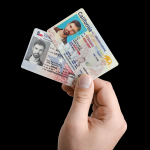Understanding Real ID: A Foundation for Secure Identification
In 2005, the U.S. Congress introduced the Real ID Act as part of broader efforts to enhance national security. This legislation established minimum security standards for state-issued driver licenses and identification cards. By 2025, a Real ID-compliant card will be required to board domestic flights, access federal facilities, or enter nuclear power plants. For foreign-born residents, obtaining a Real ID involves a tailored verification process that confirms both identity and legal presence in the U.S.
Unlike standard driver licenses, Real IDs include enhanced security features such as holographic images, barcodes, and machine-readable zones. These measures deter fraud and ensure that each card corresponds to a verified individual. For foreign-born individuals, this verification goes beyond basic identity checks—it ties directly to their immigration status and authorization to reside in the country.
Why Verification of Foreign-Born Residents Matters
The verification process for foreign-born residents serves two primary purposes. First, it ensures that only individuals with valid legal status receive a Real ID, aligning with federal security goals. Second, it provides foreign-born residents with a reliable form of identification that can be used for daily activities, employment, and travel. Without proper verification, individuals may face barriers to accessing essential services or participating fully in community life.
This process also helps states maintain accurate records. By cross-referencing immigration documents with federal databases, states can prevent identity theft and reduce the risk of fraudulent IDs being used for illegal activities. For foreign-born residents, completing the verification successfully means gaining peace of mind that their identification is recognized nationwide.
Step-by-Step: How Foreign-Born Residents Verify for Real ID
Obtaining a Real ID as a foreign-born resident involves several distinct steps. While specifics may vary slightly by state, the core process remains consistent across most jurisdictions. Here’s a detailed breakdown:
1. Gather Required Documentation
Before visiting a state Department of Motor Vehicles (DMV) office, collect all necessary documents. These typically fall into three categories:
– **Proof of Identity**: A valid, unexpired passport from your country of origin, or a Consular Identification Card (if applicable).
– **Proof of Legal Presence**: Documents showing your authorization to reside in the U.S. Examples include:
– U.S. Visa (e.g., H-1B, F-1, J-1) affixed to your passport.
– Form I-94 (Arrival/Departure Record), which can be retrieved online via the U.S. Customs and Border Protection (CBP) website.
– Employment Authorization Document (EAD, Form I-766).
– Permanent Resident Card (Green Card, Form I-551).
– **Proof of Social Security Number (SSN)**: A Social Security card, W-2 form, or a pay stub showing your full SSN. If you are not eligible for an SSN, some states accept a letter from the Social Security Administration (SSA) confirming ineligibility.
– **Proof of State Residency**: Two documents showing your current address, such as a utility bill, lease agreement, or bank statement.
2. Verify Legal Status with Federal Databases
Upon submitting your documents, the DMV will check their validity using federal systems like the Systematic Alien Verification for Entitlements (SAVE) program. This program allows states to confirm an individual’s immigration status with U.S. Citizenship and Immigration Services (USCIS). For temporary residents (e.g., students, workers), the system verifies that their authorized stay period is not expired. For permanent residents, it confirms valid green card status.
3. Complete In-Person Verification
All Real ID applicants must visit a DMV office in person. During this visit:
– You will present original documents (copies are generally not accepted).
– A DMV employee will scan your documents and take your photo and fingerprint (where required).
– You may be asked to sign a declaration affirming the accuracy of the information provided.
4. Address Additional State Requirements
Some states impose extra steps. For example:
– California requires a written or driving test for driver license applicants, even if you already hold a license from another country.
– Texas may request additional proof of insurance if applying for a driver license.
– New York mandates a vision test for all applicants, regardless of age.
Check your state’s DMV website for jurisdiction-specific rules before your appointment.
5. Receive Your Real ID
If all documents are approved, your Real ID will be mailed to your verified address within 10–15 business days. Temporary paper receipts are sometimes issued for immediate use, but these expire once the physical card arrives.
Key Documents Explained: What Foreign-Born Residents Need
Understanding which documents are acceptable is critical. Here’s a closer look at common items:
– **Passport with Valid Visa**: Must be unexpired and contain a visa that allows residency (e.g., immigrant, non-immigrant, or refugee visas).
– **Form I-94**: This electronic record shows your entry date and authorized stay duration. You can print it from the CBP website (https://i94.cbp.dhs.gov) if you don’t have a paper copy.
– **Employment Authorization Document (EAD)**: Issued to individuals authorized to work in the U.S., such as asylum seekers or spouses of certain visa holders. The EAD must be unexpired.
– **Permanent Resident Card (Green Card)**: Valid for 10 years (or 2 years for conditional residents). Expired cards are not accepted unless accompanied by a Form I-797 (Notice of Action) showing a pending renewal.
– **Social Security Documentation**: The SSA letter for non-eligible individuals must be original and state “Not Eligible for a Social Security Number” or similar wording.
State Variations in Verification Processes
While the Real ID Act sets federal standards, states have flexibility in implementation. For example:
– **Arizona**: Requires foreign-born applicants to provide a valid driver license from their home country if applying for a driver license, in addition to passing a written test.
– **Florida**: Accepts a Mexican Consular Identification Card (Matrícula Consular) as proof of identity for individuals who cannot provide a passport.
– **Illinois**: Offers “Judicial Determination” as an alternative for individuals without standard immigration documents (e.g., survivors of human trafficking). This requires a court order confirming identity and legal status.
Always check your state’s DMV website for up-to-date requirements. Links to state DMV sites are available on the U.S. Department of Homeland Security (DHS) Real ID page.
Common Challenges and Solutions for Foreign-Born Applicants
Even with careful preparation, foreign-born residents may encounter obstacles. Below are five frequent issues and practical solutions:
1. Missing or Expired Immigration Documents
**Problem**: Your I-94 has expired, or your EAD is no longer valid.
**Solution**: If your legal status is still valid (e.g., you have a pending extension), provide a Form I-797 (Notice of Action) from USCIS showing the extension request. For lost documents, request replacements via USCIS (e.g., Form I-102 for a replacement I-94).
2. Name Mismatch Between Documents
**Problem**: Your passport lists “Maria Garcia,” but your lease shows “Maria G. Garcia.”
**Solution**: Provide a legal document explaining the discrepancy, such as a marriage certificate, court order, or an affidavit from a notary public confirming both names refer to you.
3. Inability to Provide a Social Security Number
**Problem**: You’re in the U.S. on a student visa (F-1) and not eligible for an SSN.
**Solution**: Obtain a letter from the SSA stating your ineligibility. This letter must be original and include your full name and date of birth.
4. Documents in Non-English Languages
**Problem**: Your birth certificate is in Spanish, and the DMV requires English translations.
**Solution**: Use a certified translator (notarized or approved by the American Translators Association) to translate documents. The translation must include a statement that it’s an accurate representation of the original.
5. Delays in Federal Verification
**Problem**: The DMV tells you your SAVE check is taking longer than expected.
**Solution**: Ask the DMV for a case number and follow up with USCIS directly (1-800-375-5283). In some cases, providing additional documentation (e.g., a recent pay stub showing work authorization) can expedite the process.


